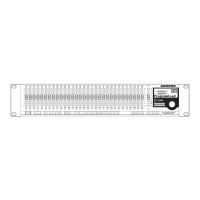
Do you have a question about the Samson D-2500 and is the answer not in the manual?
| Type | Stereo Equalizer |
|---|---|
| Channels | 2 |
| Band Width | 1/3 octave |
| EQ Range | ±12 dB |
| Inputs | 2 x XLR, 2 x 1/4" TRS |
| Outputs | 2 x XLR, 2 x 1/4" TRS |
| Signal-to-Noise Ratio (SNR) | > 90 dB |
| Frequency Response | 20 Hz - 20 kHz |
| Input Impedance | 20 kΩ |
| Total Harmonic Distortion (THD) | < 0.05% |
Essential safety guidelines for operating the D2500 unit and preventing hazards.
Detailed diagram and explanation of the D2500's front panel controls and indicators.
Overview of the D2500's rear panel connections, ports, and power switch.
Step-by-step guide to initially set up the D2500 for operation in Manual mode.
Guidance on understanding the front panel switches and their functions.
Configuring system-wide parameters like input, filter bandwidth, fader range, and operating mode.
Procedure for selecting the audio input source for the D2500 unit.
Adjusting the Q factor or bandwidth for the equalizer filters (1/4, 1/3, 1/2 octave, or AUTO).
Setting the gain and attenuation range for the equalizer faders (+/-3dB, +/-6dB, +/-12dB).
Configuring the attenuation range for the master fader.
Choosing between Stereo and Dual Mono operation for the D2500.
Managing independent or simultaneous control of left and right channels.
Operating the D2500 as a standard graphic equalizer using physical controls.
Understanding fader operation, nulling, and matching EQ settings to presets.
Introduction to the D2500's digital effects processors like EQ, Gate, Delay, etc.
Accessing and adjusting the equalizer parameters via the LCD and faders.
Utilizing the automatic feedback detection and suppression system.
Configuring the noise gate to eliminate hums and buzzes from the audio signal.
Setting up the delay effect for speaker time alignment and phase correction.
Using the Enhancer to sweeten high frequencies or reduce system noise.
Applying HPF and LPF for frequency contouring or removing low-end rumble.
Setting the brick-wall limiter to protect speakers from over-level signals.
Comparing current EQ settings with previously stored presets.
Saving current equalization curves and effect settings into memory locations.
Recalling saved equalization curves and effect settings from memory.
Merging specific parameters from different presets when loading.
Configuring MIDI and D-Net for system control and communication with other devices.
Enabling the D2500 to send and receive MIDI data.
Configuring D-Net for high-speed, bi-directional data communication.
Assigning the D2500 to specific MIDI channels for control.
Setting the D2500 to receive MIDI messages in Omni mode.
Configuring for transmitting or receiving System Exclusive MIDI messages.
Setting up for transmitting or receiving MIDI Program Change messages.
Establishing MIDI or D-Net communication between the D1500 RTA and D2500.
Using the D1500 RTA to automatically equalize the system with the D2500.
Proper positioning and connection of a measurement microphone for auto EQ.
Step-by-step process for running the automatic EQ calibration.
Utilizing the D1500 to display the D2500's equalization curve and fader positions.
Wiring example for connecting the D2500 to active, self-powered loudspeakers.
Wiring example for connecting the D2500 to passive loudspeakers via a power amplifier.
Using the D2500 for individual channel equalization via mixer insert points.
Example setup for using the D2500 for main PA and monitor mixes.
Configuration using two D2500 units for stereo main and 2-channel monitor systems.